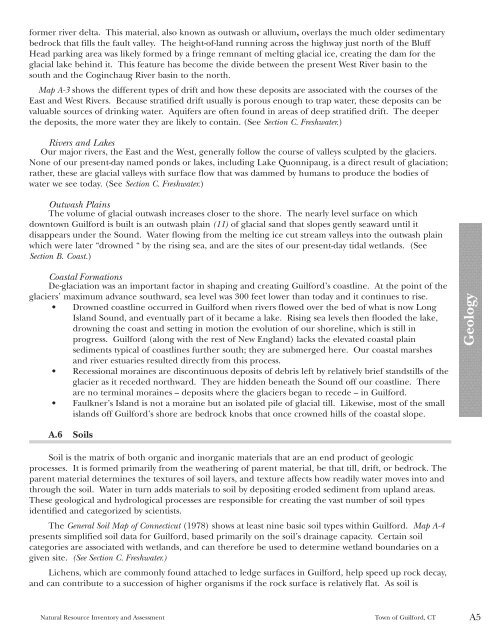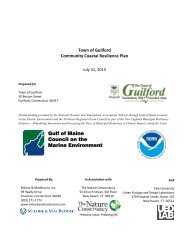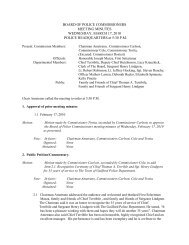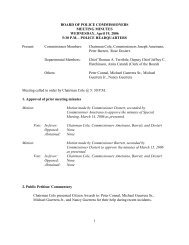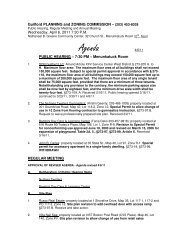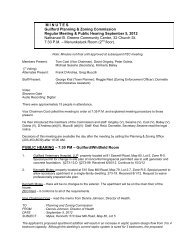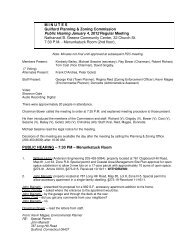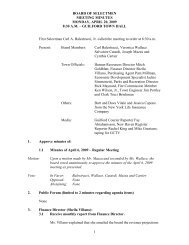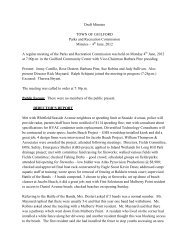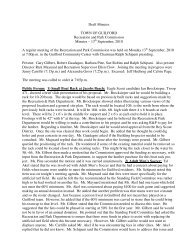Natural Resource Inventory and Assessment - Town of Guilford
Natural Resource Inventory and Assessment - Town of Guilford
Natural Resource Inventory and Assessment - Town of Guilford
Create successful ePaper yourself
Turn your PDF publications into a flip-book with our unique Google optimized e-Paper software.
former river delta. This material, also known as outwash or alluvium, overlays the much older sedimentary<br />
bedrock that fills the fault valley. The height-<strong>of</strong>-l<strong>and</strong> running across the highway just north <strong>of</strong> the Bluff<br />
Head parking area was likely formed by a fringe remnant <strong>of</strong> melting glacial ice, creating the dam for the<br />
glacial lake behind it. This feature has become the divide between the present West River basin to the<br />
south <strong>and</strong> the Coginchaug River basin to the north.<br />
Map A-3 shows the different types <strong>of</strong> drift <strong>and</strong> how these deposits are associated with the courses <strong>of</strong> the<br />
East <strong>and</strong> West Rivers. Because stratified drift usually is porous enough to trap water, these deposits can be<br />
valuable sources <strong>of</strong> drinking water. Aquifers are <strong>of</strong>ten found in areas <strong>of</strong> deep stratified drift. The deeper<br />
the deposits, the more water they are likely to contain. (See Section C. Freshwater.)<br />
Rivers <strong>and</strong> Lakes<br />
Our major rivers, the East <strong>and</strong> the West, generally follow the course <strong>of</strong> valleys sculpted by the glaciers.<br />
None <strong>of</strong> our present-day named ponds or lakes, including Lake Quonnipaug, is a direct result <strong>of</strong> glaciation;<br />
rather, these are glacial valleys with surface flow that was dammed by humans to produce the bodies <strong>of</strong><br />
water we see today. (See Section C. Freshwater.)<br />
Outwash Plains<br />
The volume <strong>of</strong> glacial outwash increases closer to the shore. The nearly level surface on which<br />
downtown <strong>Guilford</strong> is built is an outwash plain (11) <strong>of</strong> glacial s<strong>and</strong> that slopes gently seaward until it<br />
disappears under the Sound. Water flowing from the melting ice cut stream valleys into the outwash plain<br />
which were later “drowned “ by the rising sea, <strong>and</strong> are the sites <strong>of</strong> our present-day tidal wetl<strong>and</strong>s. (See<br />
Section B. Coast.)<br />
Coastal Formations<br />
De-glaciation was an important factor in shaping <strong>and</strong> creating <strong>Guilford</strong>’s coastline. At the point <strong>of</strong> the<br />
glaciers’ maximum advance southward, sea level was 300 feet lower than today <strong>and</strong> it continues to rise.<br />
• Drowned coastline occurred in <strong>Guilford</strong> when rivers flowed over the bed <strong>of</strong> what is now Long<br />
Isl<strong>and</strong> Sound, <strong>and</strong> eventually part <strong>of</strong> it became a lake. Rising sea levels then flooded the lake,<br />
drowning the coast <strong>and</strong> setting in motion the evolution <strong>of</strong> our shoreline, which is still in<br />
progress. <strong>Guilford</strong> (along with the rest <strong>of</strong> New Engl<strong>and</strong>) lacks the elevated coastal plain<br />
sediments typical <strong>of</strong> coastlines further south; they are submerged here. Our coastal marshes<br />
<strong>and</strong> river estuaries resulted directly from this process.<br />
• Recessional moraines are discontinuous deposits <strong>of</strong> debris left by relatively brief st<strong>and</strong>stills <strong>of</strong> the<br />
glacier as it receded northward. They are hidden beneath the Sound <strong>of</strong>f our coastline. There<br />
are no terminal moraines – deposits where the glaciers began to recede – in <strong>Guilford</strong>.<br />
• Faulkner’s Isl<strong>and</strong> is not a moraine but an isolated pile <strong>of</strong> glacial till. Likewise, most <strong>of</strong> the small<br />
isl<strong>and</strong>s <strong>of</strong>f <strong>Guilford</strong>’s shore are bedrock knobs that once crowned hills <strong>of</strong> the coastal slope.<br />
A.6 Soils<br />
Soil is the matrix <strong>of</strong> both organic <strong>and</strong> inorganic materials that are an end product <strong>of</strong> geologic<br />
processes. It is formed primarily from the weathering <strong>of</strong> parent material, be that till, drift, or bedrock. The<br />
parent material determines the textures <strong>of</strong> soil layers, <strong>and</strong> texture affects how readily water moves into <strong>and</strong><br />
through the soil. Water in turn adds materials to soil by depositing eroded sediment from upl<strong>and</strong> areas.<br />
These geological <strong>and</strong> hydrological processes are responsible for creating the vast number <strong>of</strong> soil types<br />
identified <strong>and</strong> categorized by scientists.<br />
The General Soil Map <strong>of</strong> Connecticut (1978) shows at least nine basic soil types within <strong>Guilford</strong>. Map A-4<br />
presents simplified soil data for <strong>Guilford</strong>, based primarily on the soil’s drainage capacity. Certain soil<br />
categories are associated with wetl<strong>and</strong>s, <strong>and</strong> can therefore be used to determine wetl<strong>and</strong> boundaries on a<br />
given site. (See Section C. Freshwater.)<br />
Lichens, which are commonly found attached to ledge surfaces in <strong>Guilford</strong>, help speed up rock decay,<br />
<strong>and</strong> can contribute to a succession <strong>of</strong> higher organisms if the rock surface is relatively flat. As soil is<br />
<strong>Natural</strong> <strong>Resource</strong> <strong>Inventory</strong> <strong>and</strong> <strong>Assessment</strong> <strong>Town</strong> <strong>of</strong> <strong>Guilford</strong>, CT A5<br />
Geology


